
Chamaecyparis pisifera is a species of false cypress, native to central and southern Japan, on the islands of Honshū and Kyūshū.

Pobitora Wildlife Sanctuary is a wildlife sanctuary on the southern bank of the Brahmaputra in Morigaon district in Assam, India. It was declared in 1987 and covers 38.85 km2 (15.00 sq mi), providing grassland and wetland habitat for the Indian rhinoceros. It holds one of the largest Indian rhinoceros population in Assam.
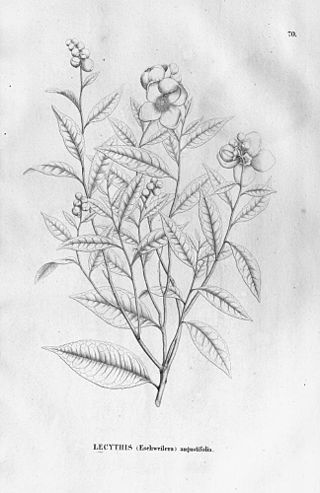
Eschweilera compressa is a species of woody plant in the family Lecythidaceae. It is found only in Brazil and is threatened by habitat loss.
Siphonaria compressa is a species of small, air-breathing sea snail. It is a pulmonate limpet, a gastropod in the Siphonariidae family.
Vatica compressa is a tree in the family Dipterocarpaceae, native to Borneo. The specific epithet compressa means "compressed", referring to the twig when young.
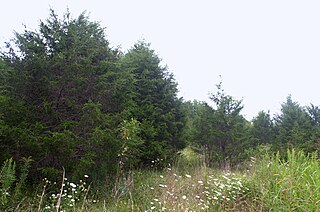
The Cedars Natural Area Preserve is a Natural Area Preserve located in Lee County, Virginia. It protects rare plant and animal species adapted to the unique conditions of a karst landscape.

Opuntia humifusa, commonly known as the devil's-tongue, eastern prickly pear or Indian fig, is a cactus of the genus Opuntia present in parts of the eastern United States, Mississippi and northeastern Mexico.

Poa compressa, the Canada bluegrass or flattened meadow-grass, is a perennial flattened meadow grass, similar to common meadow-grass, Poa pratensis. It is native to Europe but it can be found nearly worldwide as an introduced species. It grows in old wall tops, pavement cracks, dry stony grassland, and many types of wild habitat. It has a flattened stem, 23–30 cm tall, a close one sided panicle of grey green, with purple florets.

Endiandra compressa, the white bark, is a rainforest tree growing in eastern Australia. The habitat is rainforest growing near streams in valleys. The range of natural distribution is from the Nambucca River, New South Wales to Kutini-Payamu National Park, in north Queensland.

Osyris compressa is a facultatively hemiparasitic, mainly South African plant of the sandalwood family, Santalaceae. Until recently, the favoured binomial name was Colpoon compressum, but around 2001, the genus Colpoon was included in Osyris on the basis of comparative DNA studies. That assignment is not final, however, and according to the Kew Gardens plant list, Colpoon compressum P.J.Bergius, though still in review, is the accepted name.

Amphimedon compressa, the erect rope sponge, red tree sponge, red tubular sponge, or red sponge is a demosponge found in southern Florida, the Caribbean Sea, and the Bahamas. It can be deep red, orange, brown, or black.
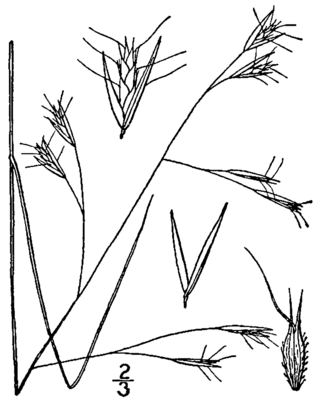
Danthonia compressa is a species of grass known by the common names mountain oatgrass, flattened oatgrass, and slender oatgrass.
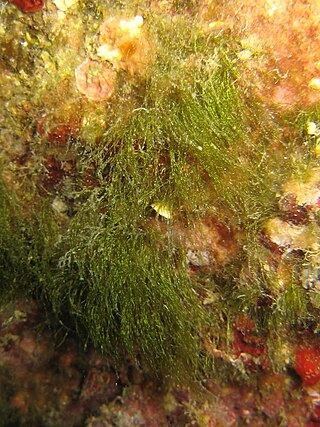
Ulva compressa is a species of seaweed in Ulvaceae family that can be found in North America, Mediterranean Sea, and throughout Africa and Australia.
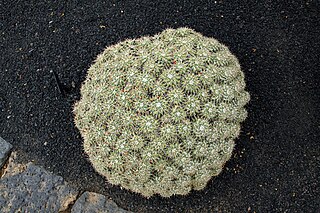
Mammillaria compressa, commonly called mother of hundreds, is a species of cactus in the subfamily Cactoideae. It is native to northern and southern Mexico, and is cultivated as an ornamental plant. It blooms in the winter and early spring, with bell-shaped flowers that range from a purplish pink to red color. Its curved spines were traditionally used as hooks for fishing.
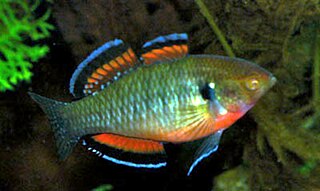
Hypseleotris compressa, the empire gudgeon, is a species of Gobiiform fish in the family Eleotridae endemic to Australia and south-central New Guinea.

Aconophora compressa is a species of insect in the treehopper family, Membracidae. It is known by the common names lantana bug, lantana treehopper, lantana stemsucking treehopper, and lantana sap-sucking bug.

Eucalyptus phenax, commonly known as green dumosa mallee or white mallee, is a species of mallee that is endemic to southern Australia. It has smooth bark, lance-shaped adult leaves, flower buds in groups of seven or nine, white flowers and cup-shaped to cylindrical fruit.
Austrostipa compressa, the compact needlegrass, originally described as Stipa compressa, is a species of grass that grows in south west Western Australia.
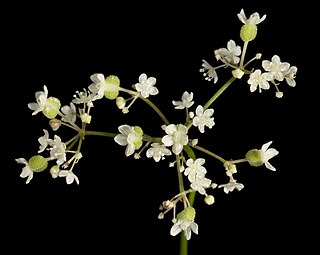
Platysace compressa, commonly known as tapeworm plant, is endemic to the south-west of Western Australia. It is an erect, ascending or low-lying perennial herb, sometimes with no leaves, or leaves reduced to scales, on flat, winged stems.

Magnolia compressa is a species of flowering plant in the family Magnoliaceae, native to Yunnan, Taiwan, the Ryukyu Islands, and southwest Japan, and introduced to South Korea. A small tree when in cultivation, it is hardy only to USDA zone 10. It may be planted in containers and brought indoors in the winter.
















